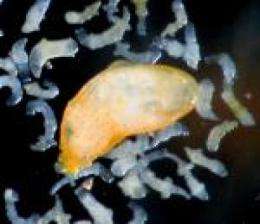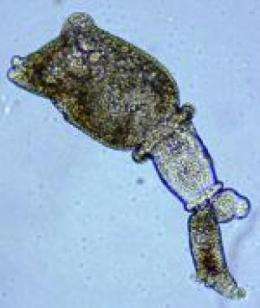'Warrior worms' discovered in snails; Scientists see possible biomedical applications

Scientists at UC Santa Barbara have discovered a caste of genetically identical "warrior worms" -- members of a parasitic fluke species that invades the California horn snail. The findings are reported in the early online version of the Proceedings of the Royal Society B.
"We have discovered flatworms in colonies with vicious, killer morphs defending the colony," said Armand M. Kuris, professor of zoology, in the Department of Ecology, Evolution and Marine Biology. "These flukes have a strongly developed social organization, much like some insects, mammals and birds." The tiny warrior worms are only a couple of millimeters in length, yet they are powerful thanks to relatively large mouths.
These worms form colonies in snails. Reproductive worms and soldier worms cooperate to grow and defend their colony within the snail. These two types of individuals look and behave differently, explained first author Ryan F. Hechinger, assistant research biologist with UCSB's Marine Science Institute. The warrior worms attack other invasive parasites trying to invade the snail.
Kuris calls the worms parasitic "body snatchers," because they castrate the snail, making it unable to reproduce. The snail, which is only an inch and a half long, houses thousands of worms. A mature colony of this type of worm weighs 25 percent of the weight of the host snail.
The worms are produced through asexual reproduction and their relationships are even more dramatic than those among honeybees. For example, worker bees and queen bees are related as sisters through sexual reproduction. "The fluke castes described by our research team are genetically identical," said Hechinger. "They are clones."

Many other species of flukes probably have colonies of clones with castes, said Kuris. He expects international research to expand in this direction, now that this example has been discovered.
These colonies also act like an immune system, defending the body of the snail from other fluke infections, said second author Alan C. Wood, a marine science lab manager at UCSB. The soldiers behave like white blood cells; they attack other unrelated flukes, biting and killing them.
These flukes with soldier castes may also have a biomedical application. They might be used in the biological control of major human parasitic diseases such as blood flukes. There are 200 million cases of blood fluke diseases worldwide, said Kuris. The soldier worms might eliminate infections from forming in the snail hosts, preventing infections in humans. Liver flukes might also be controlled.
Provided by University of California - Santa Barbara


















